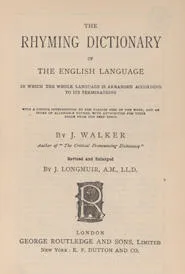
The Hamilton Collection
The Foyle Special Collections Library holds just over 300 printed books, previously owned by Sir Ian or his wife. The collection attests to the couple’s varied interests, tastes, and reading habits between the later years of Queen Victoria’s reign and the Second World War. It contains works of military history and biography, including books relating to the Boer Wars, the Russo-Japanese war, and Gallipoli and its aftermath (many bearing annotations and markings). A large part, however, is made up of literature, art history, philosophy, and even some opera scores.
Hamilton was himself a prolific author. Along with his essays, memoirs and military textbooks, the Collection includes several copies of his poems, collected under the title Now and then (1926), and his copy of Walker’s Rhyming dictionary of the English language.
Nearly half the books in the Collection belonged to his wife of over 50 years, Jean Miller Hamilton (1861-1941). The daughter of Sir John Muir, a Glasgow businessman who had extensive interests in India, she met her husband in 1886 while on a visit to Simla, and they were married in Calcutta the following year.
Like Sir Ian, Jean Hamilton was an enthusiastic reader and writer of poetry. She also kept a detailed journal. Her books contain many inscriptions and annotations, both in her own handwriting and in other hands (in some cases as yet unidentified). Readers consulting items from her library will frequently come across enclosures of newspaper cuttings, review articles, pieces of correspondence, and fragments of poetry in manuscript; here again there are questions relating to provenance still to be resolved.
As well as reflecting the Hamiltons’ shared interest in literature, the collection throws light on the couple’s friendships with contemporary writers. The various homes they shared, particularly their London house in Hyde Park Gardens, where they settled in 1913, enabled Sir Ian and Lady Hamilton to entertain their wide circle of literary and artistic friends. Books once in their possession contain authorial dedications from, amongst others, John Drinkwater, Laurence Binyon, John Masefield, and Elizabeth von Arnim.